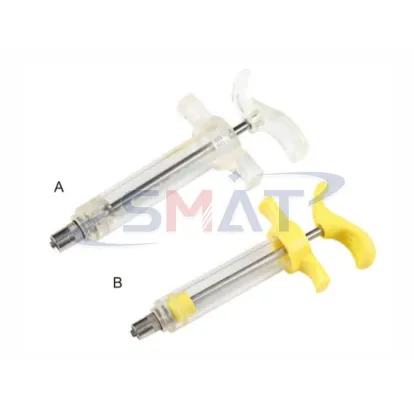What are the Types of Veterinary Syringes?
A veterinary syringe is a handheld device used for delivering precise volumes of medications, fluids, vaccines, or other substances directly into an animal's body. The syringe consists of a barrel, plunger, and a needle or nozzle. It allows veterinarians and animal caregivers to administer treatments accurately, ensuring the well-being of their patients.

Types of Veterinary Syringes
Veterinary syringes come in various types, each designed to suit specific purposes and applications. Some common types include:
1. Disposable Syringes
Disposable syringes are single-use syringes made of plastic. They are economical and hygienic, as they are disposed of after a single use, preventing the risk of cross-contamination. These syringes come in various sizes to accommodate different dosage requirements.
2. Luer Lock Syringes
Luer lock syringes have a threaded tip that securely attaches the needle to the syringe, preventing accidental detachment during use. These syringes are ideal for administering thick or viscous medications, as the threaded connection ensures a tight seal.
3. Catheter Tip Syringes
Catheter tip syringes have a longer, tapered nozzle designed for administering medications through catheters or feeding tubes. They allow for precise delivery of fluids directly into the animal's bloodstream or stomach.
4. Insulin Syringes
Insulin syringes are specifically designed for administering insulin to diabetic animals. They have a fine needle and are calibrated to deliver small and accurate doses of insulin.
5. Oral Syringes
Oral syringes have a curved tip that makes it easier to administer medications directly into the animal's mouth. They are commonly used for liquid medications or supplements.
6. Piston Syringes
Piston syringes, also known as self-filling syringes, are designed for ease of use and accuracy. They have a built-in mechanism that automatically draws in the required dosage when the plunger is pulled back.
Importance of the Veterinary Syringe
The veterinary syringe holds immense importance in animal healthcare for several reasons:
Accurate Medication Dosage
Precise dosage is critical in animal healthcare to ensure the safety and effectiveness of treatments. Veterinary syringes allow for accurate measurement and delivery of medications, reducing the risk of under or over-dosing.
Convenient Administration
Veterinary syringes provide a convenient and controlled method of administering medications. They allow veterinarians to deliver treatments directly to the target site, ensuring quick absorption and response.
Versatility
The various types of veterinary syringes cater to a wide range of medical scenarios, from vaccinations to administering critical medications. Their versatility makes them an essential tool in every veterinary clinic and animal healthcare setting.
Minimizing Stress for Animals
The precise and quick administration of medications with a syringe helps minimize stress and discomfort for animals. This is particularly important in cases where regular treatments or injections are necessary.
Disease Prevention through Vaccination
Vaccination is a vital component of preventive healthcare in animals. Syringes enable veterinarians to administer vaccines accurately, protecting animals from infectious diseases.
Conclusion
The veterinary syringe is an essential tool in the field of animal healthcare, enabling precise and controlled administration of medications and vaccines. Its various types cater to diverse medical needs, making it a versatile instrument for veterinarians and animal caregivers alike.
At Shimu Apparatus, we are dedicated to promoting the well-being of animals through comprehensive healthcare practices. We hope this article has shed light on the significance of the veterinary syringe and its indispensable role in providing optimal care for our beloved animal companions.



